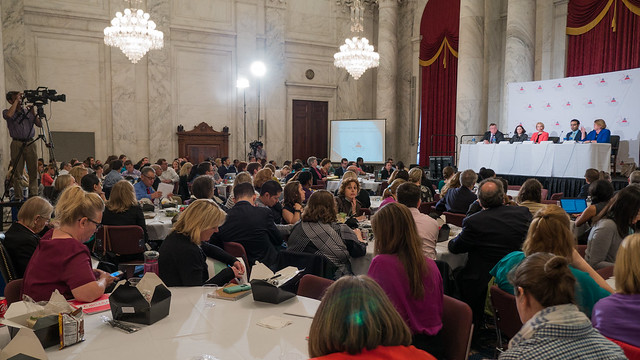This briefing examined the current state of play and critical issues facing the individual health insurance market. Our panel focused both on proposals for stabilizing the individual market in the near term, and on the longer-term challenges and solutions for non-group insurance.
This event is part of the Alliance’s Future of Health Care Summit Series, which focuses on the future of health care, chronic care, and the health care workforce.
- Deep Banerjee, director, S&P Global
- Karen Pollitz, senior fellow, Kaiser Family Foundation
- Cori Uccello, senior health fellow, American Academy of Actuaries
- Brian Webb, assistant director for health policy and legislation, National Association of Insurance Commissioners
- Sarah Dash of the Alliance for Health Reform moderated
Key Takeaways
The individual market is relatively small, covering about 8 percent of the nonelderly population or about 20 million people who can’t get coverage elsewhere through an employer, Medicare or Medicaid. While individual insurance is “still a very fragile market” after a rocky start for the marketplaces created by the Affordable Care Act (ACA) in 2014, health insurer financial performance in 2016 saw “marked improvement,” according to Deep Banerjee, a director with S&P Global Financial Services Ratings Group.
The ACA “entirely transformed” the individual market, according to Karen Pollitz, a senior fellow at the Kaiser Family Foundation. Before the ACA market reforms, there was no requirement to have health insurance and consumers with pre-existing health conditions either faced much significantly higher premiums or were denied coverage altogether.
Key ACA provisions designed to create a viable individual market included requiring people with access to affordable coverage to either have insurance or pay a penalty; prohibiting medical underwriting and instead using community rating to set premiums; and providing subsidies to low- and moderate-income people to make coverage more affordable.
KFF’s Pollitz said that, while the American Health Care Act passed by the House would make many changes, the two most critical changes for the non-group insurance market—repealing the individual mandate and reducing subsidies—will undermine pooling risk across both healthy and sick people: “It’s supposed to pool risk, but it can’t do that if people stay out when they are healthy and only want to buy coverage when they are sick.”
State deadlines are nearing for insurers to file proposed rates for 2018, but continued uncertainty about whether insurers will be reimbursed for cost-sharing reductions (CSRs) for lower-income people and whether the Trump administration will enforce the individual mandate could lead insurers to add what Banerjee called an “uncertainty buffer” to their premiums for health coverage.
Without funding for the CSRs, Banerjee predicted 2018 rate increases of 20 percent or more. The brunt of such large premium increases would be borne by higher-income consumers who don’t qualify for premium subsidies to buy individual coverage. Those with subsidies would be protected to some degree because, while the ACA is still law, the subsidies would increase to offset higher premiums for people of more modest means. Similarly, Pollitz cited Congressional Budget Office projections that premiums would increase an additional 15 to 20 percent if the mandate isn’t enforced.
Cori Uccello, an actuary and senior health fellow at the American Academy of Actuaries, said near-term actions to reduce uncertainty and improve market stability include continuing CSR funding, enforcing the individual mandate, increasing external funding to offset the costs of people with complex and costly health conditions, and avoiding legislative/regulatory actions that could increase uncertainty or threaten stability.
Uccello also identified four longer-term elements identified by the group’s Individual and Small Group Markets Committee as necessary for a sustainable individual health insurance market:
- Individual enrollment at sufficient levels and a balanced risk pool;
- A stable regulatory environment that facilitates fair competition;
- Sufficient insurer participation and plan offerings to provide insurer competition and consumer choice; and
- Slow underlying spending growth on health care services and high quality of care.
Brian Webb, assistant director for health policy at the National Association of Insurance Commissioners, reiterated that resolving the uncertainty over the status of CSRs for 2018 and 2019 is critical to stabilizing the individual market. “The biggest problem we have right now is uncertainty,” Webb said, adding, that decisions about market participation and premiums “are being made now, and the rates and forms are being filed in May, June, mid-July — July 17th is the last day. So, decisions have to be made by then, or else the companies are going to start building in what we call ‘loads.'”
Follow the conversation on Twitter:
#FutureOfHealthCare
Thank You to Our Sponsors
Summit Series Annual Sponsors

Future of Health Insurance Summit Sponsors

